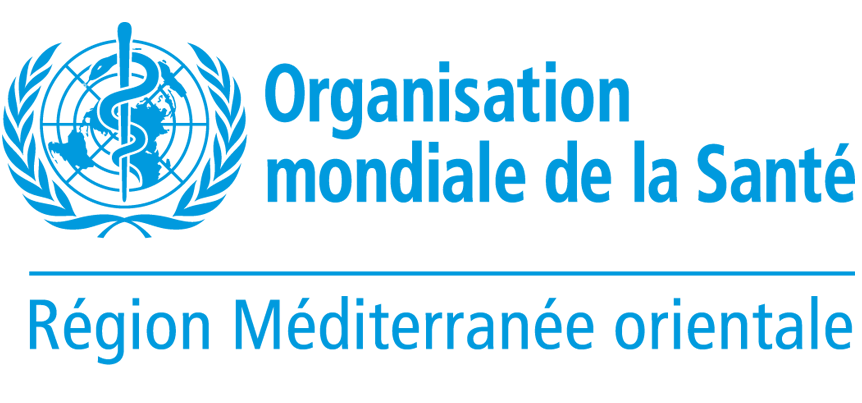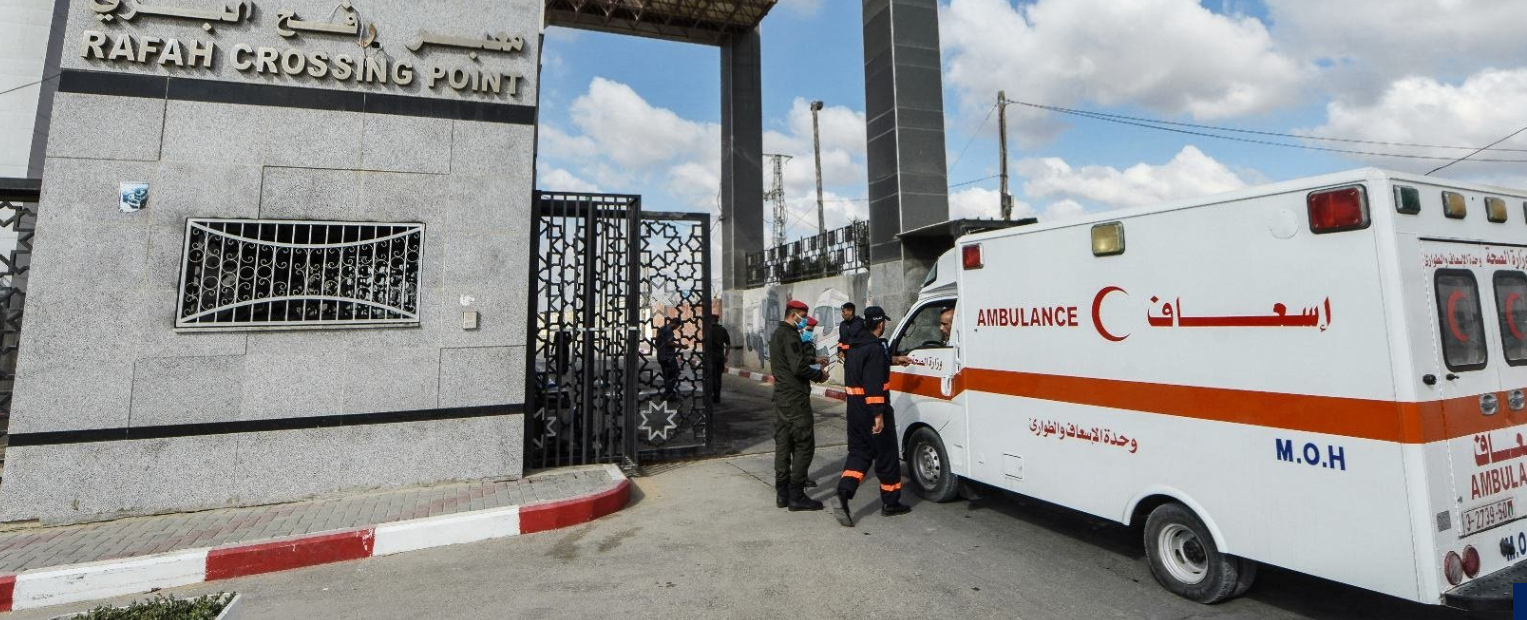WHO-led joint UN and Red Crescent mission evacuates 31 infants from Al-Shifa Hospital in Gaza
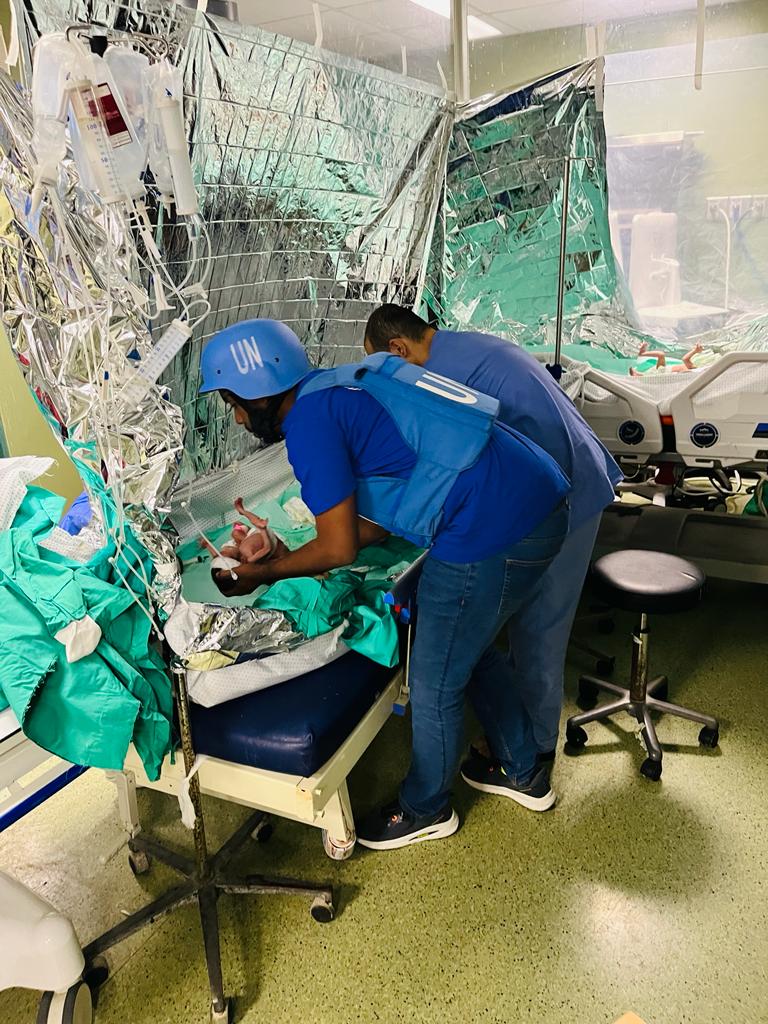 19 November 2023, Geneva/Cairo – A second WHO-led joint UN mission, working in collaboration with the Palestine Red Crescent Society, earlier today evacuated 31 babies from Al-Shifa Hospital in northern Gaza, to a hospital in southern Gaza. The severely ill babies were transported in 6 ambulances supplied and staffed by the Palestine Red Crescent. Other mission members included UN Mine Action, UNICEF and UNRWA. The mission was once again assessed as high-risk, due to the active combat taking place in close proximity to the hospital.
19 November 2023, Geneva/Cairo – A second WHO-led joint UN mission, working in collaboration with the Palestine Red Crescent Society, earlier today evacuated 31 babies from Al-Shifa Hospital in northern Gaza, to a hospital in southern Gaza. The severely ill babies were transported in 6 ambulances supplied and staffed by the Palestine Red Crescent. Other mission members included UN Mine Action, UNICEF and UNRWA. The mission was once again assessed as high-risk, due to the active combat taking place in close proximity to the hospital.
These premature and low birthweight babies had earlier been moved from the neonatal unit in Al-Shifa to a safer area in the hospital, due to lack of electricity to run their life support, and security risks in the hospital. Yesterday and last night, two babies died before the evacuation could take place. (Note, there were 33 babies under care yesterday, according to a Ministry of Health update.
The babies were successfully transported to the neonatal intensive care unit at Al-Helal Al-Emarati Maternity Hospital in southern Gaza, where they are being assessed and stabilized. Doctors there say all the babies are fighting serious infections due to lack of medical supplies and impossibility to continue infection control measures in Al-Shifa Hospital. Eleven are in critical condition.
Sadly, none of the infants were accompanied by family members, as the Ministry of Health has only limited information, and is not currently able to find close family members. Six health workers and 10 of their family members, who had been sheltering at the hospital, were also evacuated.
The evacuation, which was requested by health workers and patients during the joint mission yesterday, became necessary as Al-Shifa Hospital is no longer able to function due to a lack of clean water, fuel, medical supplies, food, other essential items and the intense hostilities. WHO remains deeply concerned about the safety and health needs of patients and health workers who remain at Al-Shifa Hospital, and in the few partially functional hospitals in the north that face imminent closure.
Al-Shifa Hospital, previously the largest and most advanced referral hospital in Gaza, together with other hospitals, must be fully restored to provide urgently needed health services in Gaza.
Today’s mission was led by senior WHO staff, including a medical specialist and a doctor, and representatives from UNICEF, UNMAS and UNRWA as noted above. It included medical staff from the Palestine Red Crescent Society, along with their ambulances. WHO is grateful for their partnership, and the support of the rest of the UN, working together as One UN.
The complex and high-risk operation, occurring in an active conflict zone, follows an assessment mission yesterday, 18 November, which included public health experts, logistics specialists, and security staff from OCHA, UNDSS, UNMAS/UNOPS, UNRWA and WHO. Today’s mission was deconflicted with the Israel Defense Forces and with the defacto authorities.
There remain over 250 patients and 20 health workers at Al-Shifa, who all request immediate evacuation. Planning is on-going to evacuate the remaining patients, their families and the health care workers. Given the complex security and logistics constraints, these evacuations will take several days to complete. Priority will be given to the 22 dialysis patients and 50 patients with spinal injuries. WHO reaffirms its respect for the dedication, professionalism, humanity and courage of the health staff who have continued to care for their patients under unimaginably difficult conditions.
WHO reiterates its plea for collective efforts to bring an end to the hostilities and humanitarian catastrophe in Gaza. We call for an immediate ceasefire, the sustained flow of humanitarian assistance at scale, unhindered humanitarian access to all of those in need, the unconditional release of all hostages—many of whom have serious medical needs—and the cessation of attacks on health care and other vital infrastructure.
Attacks on health care in Gaza Strip unacceptable, says WHO
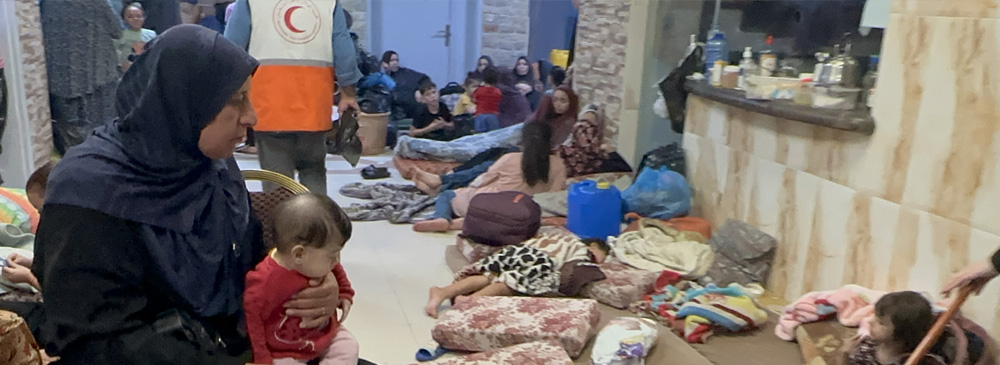
4 November 2023 — WHO condemns the attacks on 3 November near Al-Shifa Hospital, Al-Quds Hospital, and the Indonesian Hospital in Gaza City and North Gaza governorates.
According to reports, at Al-Shifa Hospital, ambulances were evacuating critically injured and sick patients to hospitals in the south of the Gaza Strip when there was an attack at the entrance of the hospital. According to early reports, at least thirteen people were killed and more than 60 injured. The hospital infrastructure and one ambulance sustained damage. This was in addition to an earlier incident that had resulted in damage to another ambulance in the same convoy.
The Palestinian Ministry of Health had earlier sent an appeal for the safe passage of a convoy of ambulances carrying wounded and sick patients from the hospital, in an effort to reduce the strain on the hospital, which is already far exceeding its bed capacity while also sheltering thousands of displaced people.
Two further attacks were reported on the same day at Al-Quds Hospital, resulting in at least 21 injuries. An additional attack was reported near the Indonesian Hospital.
Attacks on health care, including the targeting of hospitals and restricting the delivery of essential aid such as medical supplies, fuel, and water, may amount to violations of International Humanitarian Law.
WHO reiterates its call for an immediate ceasefire, emphasizing the urgent need to protect all health workers, patients, health transport, and health facilities.
Related links
WHO welcomes decision by Egypt to receive patients from Gaza Strip
WHO health supplies move towards Gaza
Joint statement by UNDP, UNFPA, UNICEF, WFP and WHO on humanitarian supplies crossing into Gaza
Lifesaving WHO health supplies land in Egypt for people-in-need in Gaza
WHO pleads for immediate reversal of Gaza evacuation order to protect health and reduce suffering
Hospitals in the Gaza Strip at a breaking point, warns WHO
Risk of disease spread soars in Gaza as health facilities, water and sanitation systems disrupted
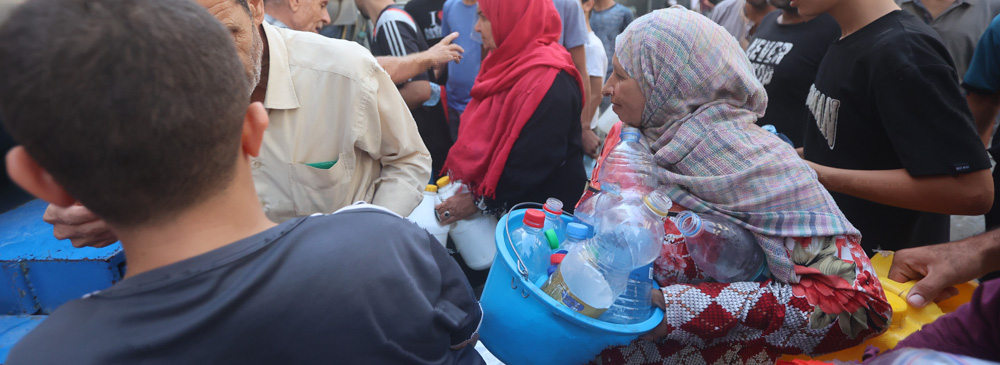
8 November 2023 – As deaths and injuries in Gaza continue to rise due to intensified hostilities, intense overcrowding and disrupted health, water, and sanitation systems pose an added danger: the rapid spread of infectious diseases. Some worrying trends are already emerging.
Lack of fuel has led to the shutting down of desalination plants, significantly increasing the risk of bacterial infections like diarrhea spreading as people consume contaminated water. Lack of fuel has also disrupted all solid waste collection, creating an environment conducive to the rapid and widespread proliferation of insects, rodents that can carry and transit diseases.
The situation is particularly concerning for almost 1.5 million displaced people across Gaza, especially those living in severely overcrowded shelters with poor access to hygiene facilities and safe water, increasing risk of infectious diseases transmission. UNRWA, WHO, and the Ministry of Health are scaling up a flexible disease surveillance system in many of these shelters and health facilities. The current disease trends are very concerning.
Since mid-October 2023, over 33,551 cases of diarrhea have been reported. Over half of these are among children under age five -- a significant increase compared to an average of 2000 cases monthly in children under five throughout 2021 and 2022. 8944 cases of scabies and lice, 1005 cases of chickenpox, 12635 cases of skin rash and 54,866 cases of upper respiratory infections have also been reported.
Disrupted routine vaccination activities, as well as lack of medicines for treating communicable diseases, further increase the risk of accelerated disease spread. This is compounded by incomplete coverage of the disease surveillance system, including early disease detection and response capacities. Limited internet connectivity and phone system functioning further constrains our ability to detect potential outbreaks early and respond effectively.
In health facilities, damaged water and sanitation systems, and dwindling cleaning supplies have made it almost impossible to maintain basic infection prevention and control measures. These developments substantially increase the risk of infections arising from trauma, surgery, wound care and childbirth. Immunosuppressed individuals, such as patients with cancer, are especially at risk of complicating infections. Insufficient personal protective equipment means that health care workers themselves can acquire and transmit infections while providing care to their patients. The management of medical waste at hospitals has been severely disrupted, further increasing exposure to hazardous materials and infection.
WHO calls for urgent, accelerated access for humanitarian aid – including fuel, water, food, and medical supplies – into and throughout the Gaza Strip. All parties to the conflict must abide by their obligations under international humanitarian law to protect civilians and civilian infrastructure, including health care. WHO calls for the unconditional release of all hostages and a humanitarian ceasefire to prevent further death and suffering.
Note to editors
Out of almost 1.5 million displaced people, nearly 725,000 are in 149 UNRWA facilities, 122,000 are sheltering in hospitals, churches, and other public buildings, and about 131,134 in 94 non-UNRWA schools and remainder in host families.
Thousands of people are also forced to seek safety and shelter in streets near hospitals, UN offices and public shelters, putting pressure on already overstretched facilities.
Prior to the escalation of hostilities, respiratory diseases were the sixth most common cause of death in the Gaza Strip. In 2022, almost 82,000 cases of COVID-19 were reported in the Gaza strip, resulting in over 400 deaths.
As people face food shortages, malnutrition, and impending colder weather, they will be even more susceptible to contracting diseases. This is especially concerning for the more than 50,000 pregnant women and approximately 337,000 children under the age of five currently in Gaza.
Related WHO photos: Media need to register with the WHO EMRO photo library for access to images for media.
Link to register: https://photos.emro.who.int/join
Link to images: https://multimedia.who.int/asset-management/2AOJ8ZZYWFRL?WS=everydayWorkflow&Flat=y
For questions email:
Related video b-roll for media: https://who.canto.global/b/NFK4L
Related links
Attacks on health care in Gaza Strip unacceptable, says WHO
WHO welcomes decision by Egypt to receive patients from Gaza Strip
WHO health supplies move towards Gaza
Joint statement by UNDP, UNFPA, UNICEF, WFP and WHO on humanitarian supplies crossing into Gaza
Lifesaving WHO health supplies land in Egypt for people-in-need in Gaza
WHO pleads for immediate reversal of Gaza evacuation order to protect health and reduce suffering
Hospitals in the Gaza Strip at a breaking point, warns WHO
Children with cancer evacuated from Gaza for treatment to Egypt and Jordan
WHO, St. Jude Children’s Research Hospital and key countries coordinate vital humanitarian action amidst ongoing conflict
10 November 2023, Some 12 children with cancer or other blood disorders have been evacuated, with their companions, from the Gaza Strip in the occupied Palestinian territory to Egypt and Jordan so they may continue their treatment safely. Additional children are expected to be evacuated for cancer treatment as part of this initiative.
To facilitate the move, the World Health Organization (WHO) and St. Jude Children’s Research Hospital have coordinated with officials from Egypt, Israel, Jordan, the occupied Palestinian territory, and the United States of America, as well as members of the St. Jude Global Alliance, a worldwide community of institutions and foundations dedicated to helping children with cancer and other catastrophic diseases.
WHO welcomes the evacuations of children needing treatment for cancer and emphasizes that sustained, orderly, unimpeded and safe medical evacuations of critically injured and sick patients into and via Egypt through the Rafah Border Crossing are essential. In line with this, WHO and St. Jude are committed to facilitating the evacuation of more pediatric cancer patients, and their family members, as the health status of the patients and security conditions allow.
“I am relieved that children in vital need of cancer care have been able to leave the insecurity and uncertainty in Gaza and continue receiving life-saving treatment in Egypt and Jordan,” said Dr Tedros Adhanom Ghebreyesus, the WHO Director-General. “I also note the efforts, coordinated by St Jude and WHO, of all relevant authorities to put the health needs of these children first. This show of desperately needed humanitarian action should serve to motivate increased access to life-saving care to all people affected by this conflict, both inside Gaza where needs are greatest today, and beyond. I pray this initiative can inspire all parties to put health and peace first.”
The current conflict has obstructed exit for patients from the Gaza Strip, while severely restricting the entry of essential medical supplies, including chemotherapy. The two specialized hospitals offering care to cancer patients, including children, have been overwhelmed, undersupplied, exposed to attacks and, due to the insecurity, one has been forced to close. Cancer care services are therefore severely limited, meaning it is critically urgent to transfer patients outside Gaza for treatment.
James R. Downing, M.D., St. Jude President and CEO said: “Working together, WHO and St. Jude have built relationships with the global community of physicians treating children with cancer. These relationships made it possible to evacuate children from Ukraine early during that war. St. Jude has also supported pediatric cancer patients in the Eastern Mediterranean Region for more than two decades. As a result, St. Jude, working with WHO, is well positioned to facilitate the evacuation of pediatric cancer patients from Gaza.”
In 2022, 122 children in the Gaza Strip were diagnosed with cancer, mainly leukemia. But these children receive only a portion of their cancer care within Gaza due to lack of some cancer services, and, therefore, require referrals to hospitals in the West Bank, including East Jerusalem, Egypt, Israel and Jordan for further treatment.
Both WHO and St. Jude have a longstanding history of working in the Eastern Mediterranean Region, with more than 80 institutions in all 22 countries and territories in the Region part of the St. Jude Global Alliance. Five years ago, WHO, St. Jude and other global partners launched the Global Initiative for Childhood Cancer (GICC) to improve survival rate of childhood cancer to at least 60 percent by 2030 and to reduce the suffering of all children with cancer. The GICC brings together more than 100 international stakeholders working to increase capacity to deliver quality services for children with cancer and increasing the prioritization of childhood cancer at global, regional and national levels.
Note to editors
Before the escalation, about 100 patients per day were referred for treatment outside of Gaza. About 1 in 4 were children, and 1 in 3 required cancer care.
10 November 2023: The press release has been updated to correct that only one of the two hospitals in Gaza providing specialized cancer care has closed, while the second remains partially operational.
